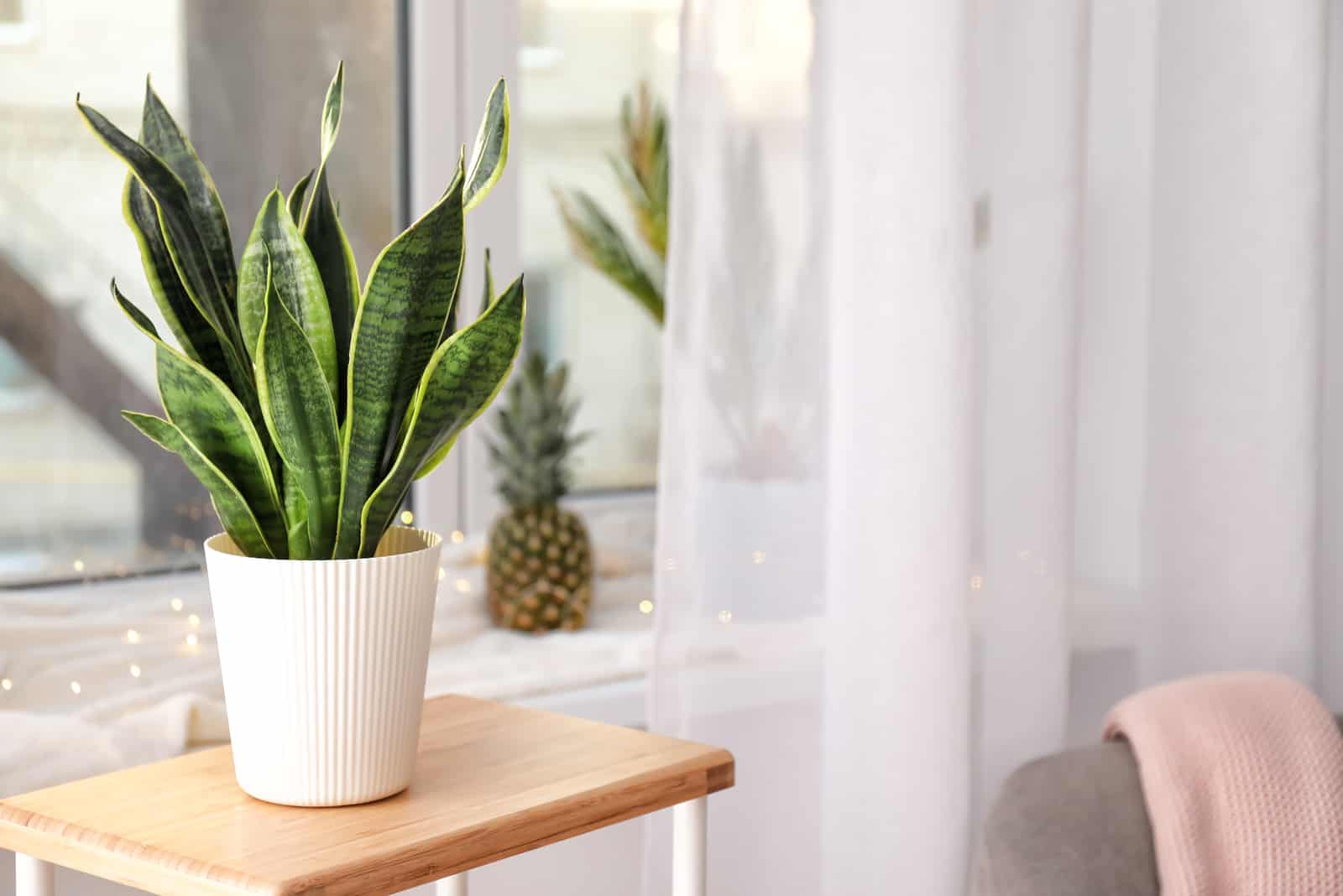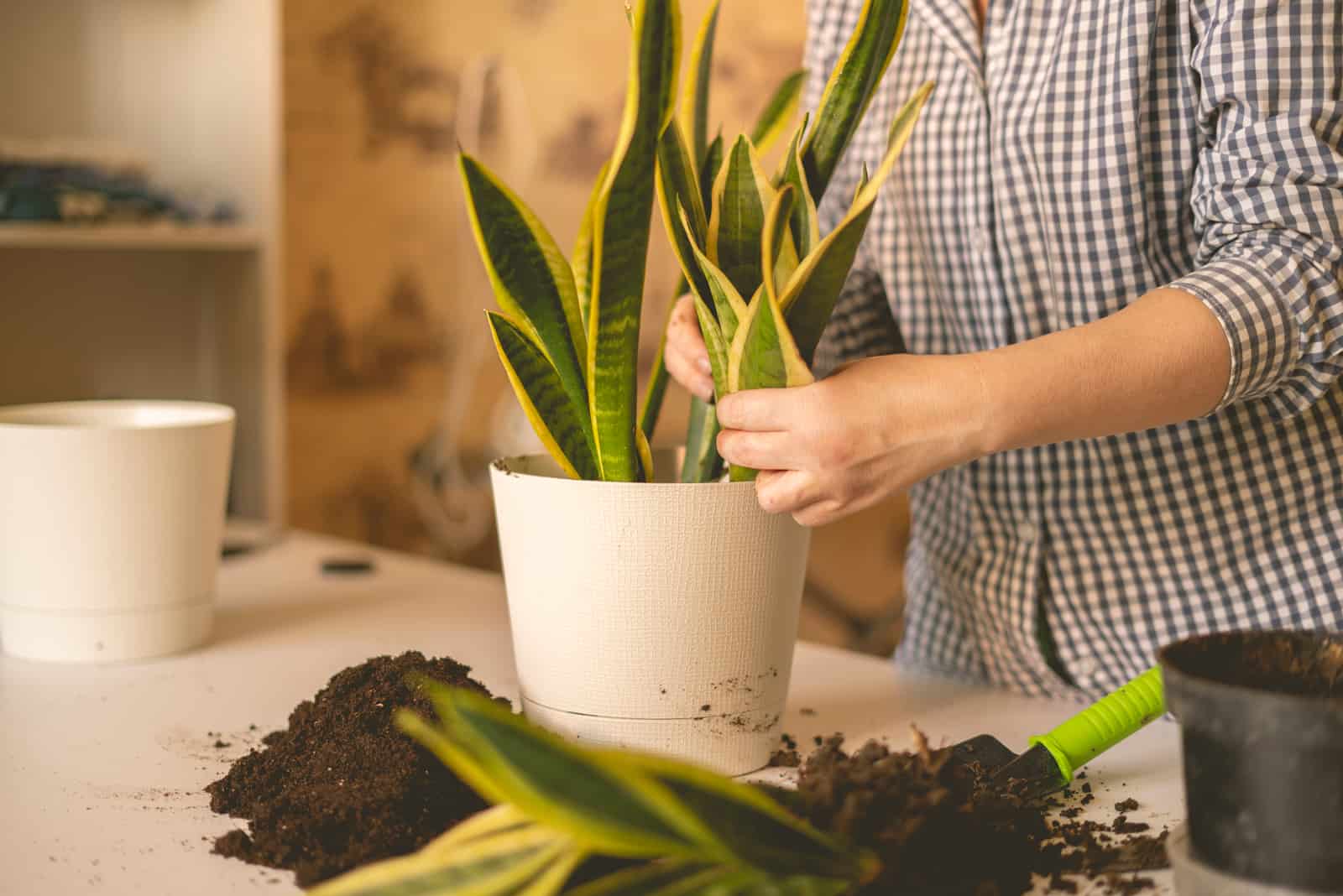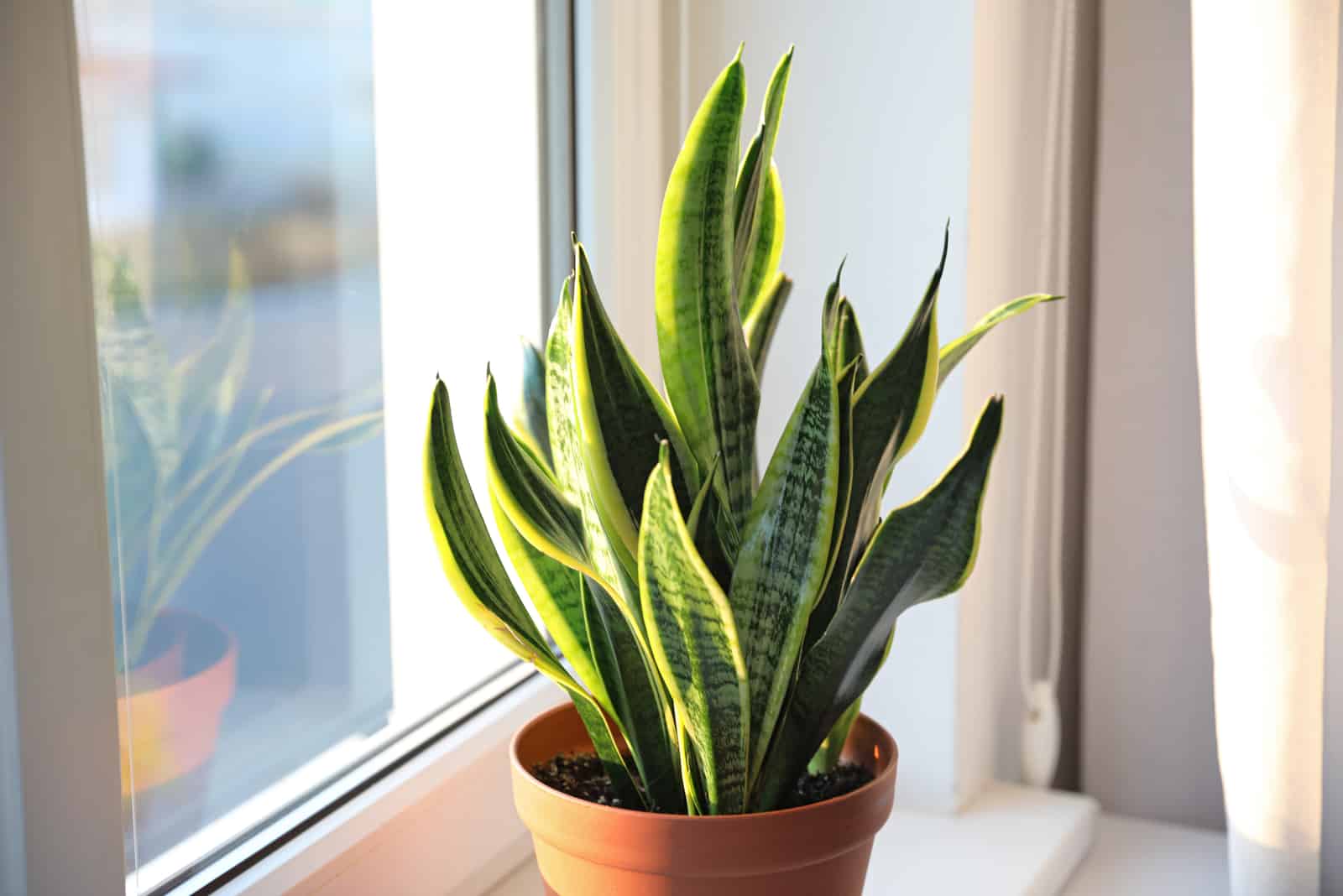Before you purchase a snake plant, you should know some basics so you can prepare everything the snake plant needs.
As I’m afraid of snakes, my first encounter with snake plants made me think of their size, and it made me wonder, how fast do snake plants grow?
I got a snake plant a few years ago when I was a beginner in growing plants, and now my snake plant has reached its mature size.
I’m going to share my experience with my snake plant with you, including how fast it grows, some tips on how to grow it faster, and why your snake plant may have a poor growth rate.
Before we get into details, here is some general info:
[table id=47 /]Now let’s find out how fast snake plants grow!
How Fast Do Snake Plants Grow?
The growth rate of a snake plant depends on many factors. These are slow-growing plants, and if they are provided with the necessary conditions they can grow between two and twelve inches per year.
This indoor plant will reach its mature size in 5 to 10 years.
When it comes to height, it’s essential to consider the type of snake plant.
Types Of Snake Plant And Expected Growth
Each type of snake plant differs in size. Therefore, to understand how fast snake plants grow, you have to consider the size of the different kinds. Although the growth rate is the same for each type, you can’t expect snake plants to be the same height or length.
Let’s look at the most common types of snake plants and their mature sizes.
Sansevieria Trifaciata Laurentii – This plant is mainly known by its other name: Mother-In-Law’s Tongue. It can grow up to 3 feet tall. This type also differs in propagation, as it’s propagated mainly by division to get a new snake plant.
Sansevieria Cylindrica (Spear Sansevieria)- This type can grow over 7 feet tall.
Sansevieria Twisted Sister – This variegated type can grow up to 12 inches.
Sansevieria Hahnii (Bird’s Nest Snake Plant) – This snake plant is the tiniest type of all. It can grow up to 6 inches.
Factors That Contribute To Growth
As we mentioned, many conditions affect the growth of this houseplant.
The way you care for this indoor plant will determine its growth rate.
The Sansevieria needs to be planted in the right pot and potting soil. It should be watered according to the schedule designed for these plants. As well as that, the temperature and humidity levels have to be regulated.
Let’s get into details.
Adaptation
The snake plant will need some time to adjust to its new environment after you bring it home. Adaptation is a process, and like human beings need some time to adapt, as do plants.
I completely understand the adaptation process. It was challenging for me to move to the coast because I lived in the mountains my entire life.
Your snake plant was first packaged, then traveled to your home, and was finally repotted.
Postpone fertilizing and check if the potting soil is dry. If it’s dry, then water the plant.
Potting Mix
As with every other plant, potting mix plays an essential role in snake plant care. The plant absorbs all the nutrients and minerals it needs from the soil.
The soil should be well-draining to prevent overwatering. Each plant requires a different type of potting mix, and we will go into details about the potting mix in the section “How to make snake plants grow faster”.
Season
Sansevieria plants have a growing season, and only grow within it. The growing season lasts from spring to summer, and this is when you fertilize and water the plant so it proliferates.
Snake plants can grow up to 3 feet in length during the growing season. As mentioned, this will vary from type to type.
By using fertilizer, you contribute to the healthy growth of your plant.
Don’t worry if you don’t notice any signs of growth during winter. The snake plant needs some rest and goes into its dormancy phase at this time.
Watering Schedule
The watering schedule is the most essential factor for healthy growth. The best time to water the snake plant is when the soil is dry to avoid overwatering, but don’t let the soil dry out completely as it can lead to dehydration.
The list below will help you understand the way snake plants should be watered. If you stick to these suggestions, you can expect optimal growth.
• If you can’t decide whether the soil has had enough water, put your finger in the soil to inspect the moisture levels.
• During summer, wait until the potting soil completely dries out to avoid accidental overwatering.
• During winter and fall, watering should be reduced. Bear in mind that the need for nutrients provided by watering drastically decreases in this period, as the plant doesn’t use energy in its dormancy period.
• Water over the soil’s pot, and avoid watering the leaves.
The great thing about snake plants is that their leaves absorb water, just like the leaves of succulents.
Pruning
Pruning is another factor that affects snake plant growth rate, and it helps the plants grow bushier.
You should prune the leaves that affect the bushy appearance. By removing these leaves, you will get the desired look and allow the plant to grow better.
As snake plants require pruning, you should pay attention to a couple of things.
First, the plant needs pruning only during the growing season. As the plant is dormant during winter and doesn’t experience new growth, pruning can cause shock.
Before trimming your snake plant, always make sure that your tools, like pruners or scissors, are sterilized. This will prevent infections from spreading if there are any, and it will also help the plant fight pests and diseases.
If there are any yellow or brown leaves (some rhizomes may be going in the wrong direction), prune them as they aren’t beneficial for the plant and can cause some additional stress to the plant.
After pruning, water the plant and put it in your desired place for it.
Temperature And Humidity
Snake plants grow well at room temperature.
There aren’t any problems related to temperature when snake plants are grown as indoor plants. You should pay attention to the heat sources within a room during the winter months. Keep the plant away from radiators or fireplaces.
Snake plants grow best in moderate humidity levels.
During the dormancy period, these plants respond well to low humidity.
If you aren’t sure about moisture levels during the growing season, you can use a humidifier to achieve the moderate humidity level that these plants need. As bathrooms have higher humidity levels, you can place the plant there.
Keep your Snake plant away from vents and air conditioners to avoid dry air damage to the plant.
Pot Size
Pot size is an essential factor that affects the growth of these plants.
Small pots won’t leave much space for roots to spread, and the plant will end up root bound.
There is one general rule for pot size when it comes to the snake plant.
For example, if the plant is 1 foot tall, you should consider purchasing a 2-gallon pot, and if the plant is 2 feet tall, buy a 3-gallon pot, and so on.
Fertilization
The growth rate also depends on fertilizing, and it plays a crucial role in achieving bushy and healthy growth.
Snake plants need to be fertilized once or twice during the growing season.
When the fall comes, you should reduce fertilizing by 50%. During winter, snake plants go through their dormancy phase and don’t need any fertilizers.
When you fertilize the plant, give it a weak dose of fertilizer, The Nitrogen, Phosphorus, and Potassium ratio should be 10:10:10, or 20:20:20.
It’s worth mentioning that the feed should be diluted following the instructions provided on the package.
How To Make A Snake Plant Grow Faster – Tips
Although some may think that snake plants have too many disadvantages, I think it’s worth growing them. Once you have ensured all the growing conditions the snake plant needs, there are some extra tips to help you improve the growth rate of snake plants.
These are so-called hacks to improve the growth of your snake plant.
Let’s take a look.
Choose Adequate Potting Mix
As previously mentioned, soil mix plays an essential role in the healthy growth of Sansevieria plants.
You can get perfect soil if you mix three ingredients:
• Well-draining soil
• Cacti or succulent soil
• Compost
The soil should contain 25% compost and a 1:1 ratio of well-draining soil and cacti or succulent soil.
Cacti soil is used to improve drainage and help provide the minerals and nutrients the plant needs.
Compost will make a great addition for macronutrient and micronutrient factors.
Find A Better Place For Your Snake Houseplant
This is primarily related to light conditions, which directly affect the growth of your snake plant.
The plant generally responds well to different light levels, but you should find a new place to help it grow faster.
The best place for this plant is a place with bright indirect light.
Why is that? Excess direct sunlight exposure will damage the leaves and low light will stunt the growth.
How Do I Know If My Snake Plant Is Getting Enough Light?
It’s simple, your plant should look healthy and have the growth rate shown above.
To make sure, place the snake plant near a window with bright light. The best would be to put the plant near a south-facing window.
If you want to boost light levels, you can use a grow light.
Repot The Snake Plant
Now you know the perfect pot size for this plant.
Although these plants are slow growers and need to be repotted every 2 to 6 years, it’s really important to understand that the plant will grow faster if you repot it.
Experienced growers will tell you that the moment you notice the root system is outgrowing the pot is the perfect time to repot.
Make sure that the new pot has drainage holes to remove excess water. Use fresh soil mix and a bigger pot.
Here’s a video:
Reasons For Poor Sansevieria Growth Rate
As mentioned, snake plants can grow up to 12 inches per year and reach mature size in 5 to 10 years. Sometimes various issues can occur to stunt the growth of the snake plant.
The issues are mainly caused by mistakes in snake plant care.
Keep reading to find out more.
Root Rot
One of the most common reasons for a snake plants’ poor growth rate is root rot.
Although this sign may be the hardest to spot, there are ways to check it.
First, take a look at the leaves. If they are drooping or have brown spots, the root system demands further observation.
Another indicator of root rot is an unpleasant smell. Therefore, if there’s an unpleasant smell coming from the soil, the snake plants’ roots are likely in danger!
If you notice this sign of overwatering, you need to act immediately!
A healthy root system is vital because it directly affects the other parts of the plant.
Overwatering will cause soggy soil, so be sure to read everything you need to know about soil. Waterlogged soil will increase the plant’s susceptibility to diseases caused by pathogens.
Droopy Or Yellowing Leaves
Plants need oxygen (fortunately, they produce more than they take). Excess water will disrupt the airflow in the root system, lowering the amount of oxygen the plant needs.
As a consequence, the leaves will become droopy.
On the other hand, yellowing leaves can be caused by both overwatering and underwatering.
Therefore, if you spot yellow leaves, check the soil.
Slow Growth Due To Underwatering
The snake won’t show any obvious signs like changes to the leaves when it’s underwatered.
You will only notice stunted growth. If you see that the soil has dried out, you might want to adjust the watering schedule.
Pests
If you notice poor growth of your snake plant, inspect the plant and see if there are any signs of pests. The most common problems affecting the snake plant are spider mites and mealybugs.
By using rubbing alcohol or dish soap, you can quickly get rid of mealy bugs. Mix alcohol with dish soap and spray it over the mealy bugs.
You can also use neem oil.
Spider mites cause the appearance of tiny spots on the leaves that can be either brown or white.
You can get rid of spider mites using alcohol and water. Dip a cloth in the mixture and gently rub the leaves. You can also use dish soap or neem oil. Mix it with water, dip in a cloth, and gently rub the leaves.
It is essential to remove pests from the leaves as they can damage the entire plant and prevent new leaves from growing.
By removing the pests, you will increase the growth rate of the snake plants.
You Forgot to Prune
As mentioned, snake plants need pruning.
So, what happens if you forget to prune the snake plant? The plant will become too bushy and the leaves will grow until they become bound and stunt the growth of the entire plant.
We have already provided you with the proper method for pruning snake plants, so you won’t have much trouble.
Brown Leaf Tips Due To Overfertilizing
If you use more fertilizer than the snake plant needs, there will be consequences.
It will affect appearance and growth. The tips of the leaves will turn brown and cause the withering of the plant.
The key for fertilizing is consistency, as it can also prompt drooping leaves.
It will stunt the growth, but it also causes permanent damage to the snake plant, and you won’t be able to revive it.
If you notice that the leaf tips on your snake plant have started turning brown, act as soon as possible.
You should put the plant in the sink with running water, then flush the compost. You can do this 3 to 4 times to eliminate all excess fertilizer.
After that, replant the snake plant using a new pot and postpone fertilizing for a month.
Stick to the usual watering schedule.
FAQs
How many leaves does a snake plant have?
A snake plant will grow 2 to 3 new leaves during a growing season. As the snake plant goes through the dormancy phase during winter, the leaves aren’t expected to grow. This number of leaves can only be expected if you ensure all conditions the snake plant requires.
What are the benefits of snake plants growing fast?
The benefits of snake plants are similar to those of spider plants. They include filtering indoor air, toxic pollutant removal, and mental health-boosting. Snake plants are effective against allergies and can relieve minor physical ailments.
What is the fastest-growing snake plant?
It is impossible to determine which snake plant has the fastest growth rate. Each type has the same growth rate if provided with the right conditions. The only difference between different types of snake plants for growth is their mature size.
Wrapping Up
Congrats, you have made it to the end!
You found out the answer to the question, how fast do snake plants grow? These plants with unusual names will make a great addition to your home decor.
As the growth rate depends on many factors, make sure to improve each so that your plant reaches its mature size as soon as possible.
Until next time!
Like this post? Share or pin it for later!







